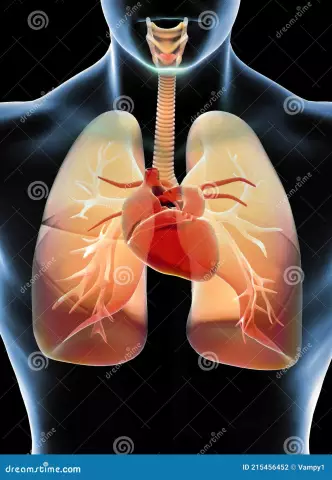- Author Curtis Blomfield [email protected].
- Public 2023-12-16 20:44.
- Last modified 2025-01-23 17:01.
Respiratory disorders are any significant deviations in the characteristics of respiratory movements (rhythm, depth, frequency) from accepted norms.
Kussmaul breathing is a special pathological condition that is accompanied by difficult and deep breathing, which is often based on severe metabolic acidosis caused by kidney failure or diabetic ketoacidosis.
Normal breathing
In a normal state, a he althy person's breathing is rhythmic (i.e., the intervals between breaths are equal), while inhalation is usually slightly longer than exhalation, and the number of respiratory movements (i.e. frequency) is 12-18 per minute.

During physical activity, the respiratory rate increases and can reach 25 per minute, and it can also become shallower while maintaining a normal rhythm.
Various disorders can indicate the location of damage, help to make a prognosis and determine the severity of the disease.
Pathological types of breathing
Kussmaul breathing will be described in more detail below.
Respiratory disorders are manifested by a change in its frequency, rhythm and depth. In accordance with this, the following types are distinguished:
- Bradipnea - decreased breathing. It is characterized by rare (less than 12 per minute) respiratory movements. It occurs due to increased blood pressure, hypoxia, stenosis of the bronchi and trachea, altitude sickness, drug exposure, brain damage.
- Polypnea (tachypnea) - rapid breathing. It is characterized by frequent (more than 24 per minute) respiratory movements resulting from pneumonia, fever, mental disorders, intense pain in the abdominal / chest wall (gentle breathing).
- Hyperpnea - frequent, deep breathing that occurs against the background of an acceleration of basal metabolism due to physical exertion, fever, thyrotoxicosis.
- Apnea is a temporary lack of breathing that develops as a result of a rapid increase in blood pressure, massive intoxication, hypoxia, exposure to drugs (barbiturates, ether, chloroform), a significant decrease in the amount of oxygen in the air.

Periodic breathing patterns
In addition to those described above, the so-called periodic types of breathing are distinguished, which develop as a result of disturbances in the system of excitation-inhibition of the central nervous system, they include the breathing of Biot, Cheyne-Stokes, Kussmaul.
- Biota breathing - deep breaths alternate with apnea (long pauses). It develops against the background of a coma.
- Cheyne-Stokes breathing - manifested by rare and superficial respiratory movements graduallybecoming more frequent and deeper. Reaching a maximum, they slow down again and weaken, and after a pause, a similar cycle repeats again. Occurs with coma (uremic, diabetic), brain pathologies, strokes, intoxication, circulatory disorders.

Besides, allocate:
- Gasping-breathing that accompanies the terminal stage of asphyxia (in premature babies, as well as in pathologies of the brain stem). It is characterized by rare weakening breaths, which alternate with prolonged apnea (up to 20 s) on exhalation.
- Respiration is dissociated, accompanied by asymmetry in the movements of the halves of the chest and paradoxical movements of the diaphragm. It is observed in brain tumors, circulatory disorders and severe lesions of the nervous system.
Overview (development mechanism)
Kussmaul breathing is a form of hyperventilation, in which the body tries to reduce the amount of carbon dioxide in the blood by increasing the depth or speed of breathing. At the same time, it is not deep and fast at first, but as the acidosis worsens, it gradually becomes difficult and deep. This state is called Kussmaul breathing.
Reasons for appearance
Kussmaul breathing occurs due to the following pathologies:
- Diabetic ketoacidosis is a condition when the glucose in the blood is not used by the body as an energy source due to an acute shortage of insulin, as a result of which the body is not able to get rid of excess accumulatedblood sugar. Most often, this condition is observed in type 1 diabetes mellitus.
- Metabolic acidosis is a condition that occurs with a significant increase in the amount of lactic acid in the blood, which leads to impaired functioning of the kidneys, manifested in their inability to maintain an adequate acid-base balance of the body due to a violation of the filtration function.
-

breathing kussmaul biota - Pneumonia. This pathology can also cause Kussmaul breathing. With this pathology, fluid fills the alveoli, which prevents the normal mechanism of breathing.
- Renal failure. As mentioned above, kidney dysfunction leads to an excess of lactic acid, the excess of which is not excreted from the body and leads to an imbalance of acids and alkalis. It is worth noting that before the patient has Kussmaul breathing, other symptoms that accompany renal failure come to the fore: vomiting, swelling in the legs, nausea, decreased urine output.
- Peritonitis is an inflammation of the peritoneum, the cause of which often lies in the pathologies of the liver and inflammation of the gastrointestinal tract. Deterioration in peritonitis can trigger this type of abnormal breathing.
Therapy
The treatment of such respiratory disorders begins with the treatment of the underlying pathology (uncorrected diabetes mellitus, renal failure, and so on), which will automatically remove the effects of hyperventilation.
If the cause of the respiratoryIf metabolic acidosis acts as a violation, then the main focus of therapy is to restore the pH balance and subsequent stabilization of the general condition, and then the elimination of the underlying pathology.

When breathing Kussmaul (Biot or other respiratory disorders), make sure that the patient's airways are clear and free of any obstructions. This is the most obvious reason for the violation. Determining when a patient enters a Kussmaul (Cheyne-Stokes, etc.) breath is difficult.
If there is a possibility that the patient will develop an imbalance in the pH balance, he should be hospitalized in order to carefully monitor changes in blood counts and to prevent the occurrence of pathological types of breathing, the appointment of appropriate therapy for the underlying disease.






